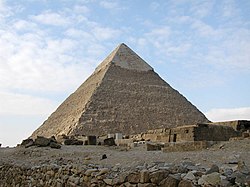
Back Piramide Afrikaans Pyramide (Bauwerk) ALS Piramide (arquitectura) AN هرم Arabic هرم ARZ পিৰামিড Assamese Pirámide (arquiteutura) AST Piramida Azerbaijani Пирамида (архитектура) Bashkir Pyramidn (Bauwerk) BAR

A pyramid (from Ancient Greek πυραμίς (puramís) 'pyramid'[1][2], from the Egyptian pir-em-us, the vertical height of the structure.[3]) is a structure whose visible surfaces are triangular in broad outline and converge toward the top, making the appearance roughly a pyramid in the geometric sense. The base of a pyramid can be of any polygon shape, such as triangular or quadrilateral, and its surface-lines either filled or stepped.
A pyramid has the majority of its mass closer to the ground[4] with less mass towards the pyramidion at the apex. This is due to the gradual decrease in the cross-sectional area along the vertical axis with increasing elevation. This offers a weight distribution that allowed early civilizations to create monumental structures.

Ancient civilizations in many parts of the world pioneered the building of pyramids. The largest pyramid by volume is the Mesoamerican Great Pyramid of Cholula, in the Mexican state of Puebla. For millennia, the largest structures on Earth were pyramids—first the Red Pyramid in the Dashur Necropolis and then the Great Pyramid of Khufu, both in Egypt—the latter is the only extant example of the Seven Wonders of the Ancient World.
- ^ πυραμίς Archived 2021-07-09 at the Wayback Machine, Henry George Liddell, Robert Scott, A Greek-English Lexicon, on Perseus Digital Library
- ^ The word meant "a kind of cake of roasted wheat-grains preserved in honey"; the Egyptian pyramids were named after its form (R. S. P. Beekes, Etymological Dictionary of Greek, Brill, 2009, p. 1261).
- ^ Petrie, Flinders (1911). . In Chisholm, Hugh (ed.). Encyclopædia Britannica. Vol. 22 (11th ed.). Cambridge University Press. p. 683.
- ^ Centre of volume is one quarter of the way up—see Centre of mass.